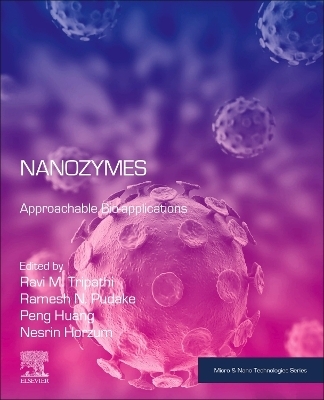
Nanozymes
Elsevier - Health Sciences Division (Verlag)
978-0-443-13788-4 (ISBN)
Dr Ravi Mani Tripathi is an Associate Professor at Amity Institute of Nanotechnology, Amity University Uttar Pradesh, Noida, India. He received his Ph.D. in Nanobiotechnology from Jiwaji University, Gwalior, India. He did his post-doctoral research at School of Pharmacy, Sungkyunkwan University, South Korea, and received the young scientist award in 2019 from the International Scientist award on Engineering, Science, and Medicine, Visakhapatnam, India. He has 15 years of teaching and research experience in Nanobiotechnology. He developed an innovative method for the biological synthesis of nanomaterials like particles, nanodots, flowers, rods, fibres, etc. and has vast expertise in the fields of antimicrobial nanomedicine, colorimetric detection, and catalytic/photocatalytic degradation of toxic pollutants. Dr Ramesh Namdeo Pudake is an Assistant Professor in Amity University Uttar Pradesh, India. Dr Pudake received his PhD from China Agricultural University, Beijing, China, and after his PhD he engaged in research in a range of topics in biotechnology. He has also worked in the Department of Agronomy at Iowa State University Ames, IA, USA on functional genomics. Currently he is focusing on the research of different nanotechnology applications in agriculture. Dr Pudake has published several book chapters and articles in prominent Journals. Dr. Peng Huang is a Distinguished Professor, Chief of the Laboratory of Evolutionary Theranostics (LET), and Director of the Department of Molecular Imaging, at the School of Biomedical Engineering, Shenzhen University Health Science Center, China. He received his Ph.D. degree in Biomedical Engineering from Shanghai Jiao Tong University in 2012. He then joined the Laboratory of Molecular Imaging and Nanomedicine (LOMIN) at the National Institutes of Health (NIH) as a postdoctoral fellow. In 2015, he moved to Shenzhen University as a Distinguished Professor. His research focuses on molecular imaging, nanomedicine, and theranostics. Dr. Huang was ranked in the top 1% of the highly cited authors community of the Royal Society of Chemistry in 2020 and 2021 and selected as the 2020 and 2021 Global Highly Cited Researcher in the field of Cross-Field by Clarivate. Dr. Nesrin Horzum studied chemistry at the Pamukkkale University, Turkey, in 2004. She did her M.Sc. and Ph.D. studies in the Department of Chemistry at the Izmir Institute of Technology. She received her doctoral degree in 2013 from the Izmir Institute of Technology, with a thesis about the applications of electrospun nanofibers in filtration processes. During her Ph.D., she joined the Max Planck Institute for Polymer Research in 2011 as a visiting scholar, investigating colloid electrospinning and surface functionalization of electrospun nanofibers. In 2014, she joined the group of Prof. Bo Liedberg at the Nanyang Technological University, where she worked at Centre for Biomimetic Sensor Science on paper-based sensing platforms. She is now Associate Professor in the Izmir Kâtip Çelebi University, Turkey. Her current research interests include filtration and sensing applications of polymeric and hybrid nanofibers, as well as smartphone-based sensors for water quality monitoring and glucose detection.
Part 1: Concept of Nanozymology
1. An overview of nanozymes
2. Classification of nanozymes based on different parameters
3. A review on nanozymes mechanisms and kinetics
4. Recent progress in synthesis of nanozymes and its functionalization
Part 2: Nanozyme for human health
5. Construction of functionally specific nanozymes for cancer theragnostic
6. Opportunities and trends in therapeutics application of nanozymes
7. An alternative approach for antibacterial application with help of nanozymes
8. Nanozymes-based detection of clinically important pathogens
9. Nanozyme for Diabetes Care
10. Nanozymes based multifunctional platforms for of Uric acid in patients
Part 3: Nanozymes for food and agriculture
11. Detection of adulteration in foods using functionalized nanozymes
12. Nanozymes-based detection of toxins, foodborne pathogens, antibiotics, and pesticides in food materials
13. Improvement in food preservation with nanozymes
14. Mechanism of nanozymes assisted plant growth promotion
15. Nanozymes based boosting of endogenous molecular machinery in plants for resistance to abiotic stress
16. Eco-friendly approach to plant-growth promotion using nanozymes and biofertilizers
17. Role of artificial enzymes in livestock health monitoring and maintenance
Part 4: Nanozyme for environmental application
18. Heavy metal pollutant detection using nanozymes
19. Colorimetric detection of hydrogen peroxide using nanozymes
20. Environmental implications of nanozymes-based pesticide monitoring in water bodies
21. Nanozymes-based detection of antibiotics in water sources
22. Environmental Remediation with Nanozymes
23. Nanozymes for preservation and restoration of cultural heritage
24. Safety concerns and toxicological aspects of novel enzymes
| Erscheinungsdatum | 22.08.2024 |
|---|---|
| Reihe/Serie | Micro & Nano Technologies |
| Verlagsort | Philadelphia |
| Sprache | englisch |
| Maße | 191 x 235 mm |
| Gewicht | 450 g |
| Themenwelt | Medizin / Pharmazie ► Physiotherapie / Ergotherapie ► Orthopädie |
| Technik ► Maschinenbau | |
| Technik ► Medizintechnik | |
| Technik ► Umwelttechnik / Biotechnologie | |
| ISBN-10 | 0-443-13788-9 / 0443137889 |
| ISBN-13 | 978-0-443-13788-4 / 9780443137884 |
| Zustand | Neuware |
| Informationen gemäß Produktsicherheitsverordnung (GPSR) | |
| Haben Sie eine Frage zum Produkt? |
aus dem Bereich


